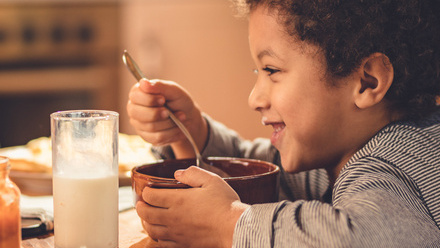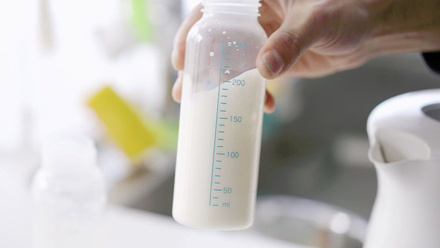Annina Whipp is a senior specialist paediatric dietitian. In this Q&A she tells us about how she manages cow’s milk allergy management in practice.
How did you become a paediatric-focused dietitian?
I was fortunate enough to secure a paediatric rotational post that enabled me to develop a foundation skillset across a range of specialties. I have held a variety of paediatric-focused roles, with extensive experience within gastroenterology. I currently work part-time for the NHS and also as a freelance dietitian, specialising in health writing.
Tell us about cow’s milk protein allergy (CMPA)
Cow’s milk protein allergy is the leading cause of food allergy in infants and children younger than three years, with a prevalence of 1.9-4.9%.1,2 The diagnosis and management can often be challenging with dietetic input central to this. Despite advancements in the field of allergy, there continues to exist misconceptions from both HCPs and parents/carers around CMPA (particularly non-IgE mediated CMPA). The gold standard approach to diagnosis is by the identification of symptoms, followed by an exclusion diet trial followed by a reintroduction phase to either confirm or exclude the allergy. This is not an easy task; therefore within this challenge also lies the opportunity for dietitians to play an integral role in supporting parents/carers to do this effectively.
What is the role of a dietitian in the management of CMPA?
Dietary exclusions and specialist formulas can be difficult to comply with. Maternal dietary exclusions may act as a barrier to breastfeeding; therefore supportive counselling by dietitians and other HCPs plays a significant role. Dietitians are best placed to provide evidence-based and practical nutritional advice to ensure that exclusion diets remain nutritionally adequate for breastfeeding mothers, infants and children. Working as a dietitian and having had to navigate food allergy as a mum has given me a unique perspective which has definitely influenced my own clinical practice.
Are you seeing an increase in CMPA prevalence?
In recent years the prescribing of specialist formulas for the management of CMPA has increased within primary care.3 It is thought that this may be due to an increased research focus on allergy; however it’s also suggested to be the result of misinterpretation of symptoms causing the misdiagnosis of cow’s milk allergy.4 This is an area that dietitians are aiming to target by introducing interventions to improve cost efficiencies and patient outcomes for infants with suspected non-IgE cow’s milk allergy.
What are the challenges in managing children with CMPA?
It is important to educate parents/carers to be able to confidently interpret food labels, alongside providing tips and inspiration for creating suitable and balanced meals. Parents/carers may feel the burden of the additional costs of ‘free-from’ foods. Dietitians can explore suitable supermarket own brands for calcium- and iodine-fortified cow’s milk-free milks, as these tend to be cheaper options.
It is vital that, during the weaning phase, an infant continues to meet their nutritional requirements, despite following an exclusion diet. Cow’s milk contains calcium, vitamin B2 (Riboflavin), vitamin B12 and iodine; therefore education should be provided in choosing dairy-alternative milks which are fortified with these vitamins and minerals.
In clinical practice, children often report feeling isolated because of their food allergy; empowering them to be prepared with suitable snacks/treats is key to minimising this. It is also important that you try to engage older children in managing their food allergy by helping children take appropriate levels of accountability. This may include educating the child to ask an adult if a food is cow’s milk-free and learning to recognise cow’s milk-containing foods.
Top tips for managing children with CMPA
- Walk in your patients’ shoes by following a dairy and soya-free diet for two-to-four weeks. Try different brands of ‘free-from’ products so you can make tasty recommendations. Read food labels when shopping so you can warn against those unexpected sources!
- A food and symptom diary is your best friend! They’re vital in helping to monitor the response to an exclusion diet or re-introduction phase.
- Develop your own resources for up-to-date product lists or suitable meal ideas and recipes. This can really help parents/carers feel prepared and remove some of the anxiety surrounding the management of a child with a food allergy.
References
- Koletzko S, Niggemann B, Arato A, Dias J, Heuschkel R, Husby S et al. Diagnostic Approach and Management of Cow’s-Milk Protein Allergy in Infants and Children: ESPGHAN GI Committee Practical Guidelines. Journal of Pediatric Gastroenterology and Nutrition. 2012;55(2):221-229
- Venter C, Broen T, Shah N, Walsh J, Fox A. Diagnosis and management of non-IgE-mediated cow’s milk allergy in infancy – a UK primary care practical guide. Clinical and Translational Allergy. 2013;3(1):23
- PrescQIPP. Appropriate prescribing of specialist infant formulae (foods for special medical purposes). 2016. prescqipp.info/media/1346/b146- infant-feeds-21.pdf
- Van Tulleken. Overdiagnosis and industry influence: how cow’s milk protein allergy is extending the reach of infant formula manufacturers. BMJ 2018;363:k5056







